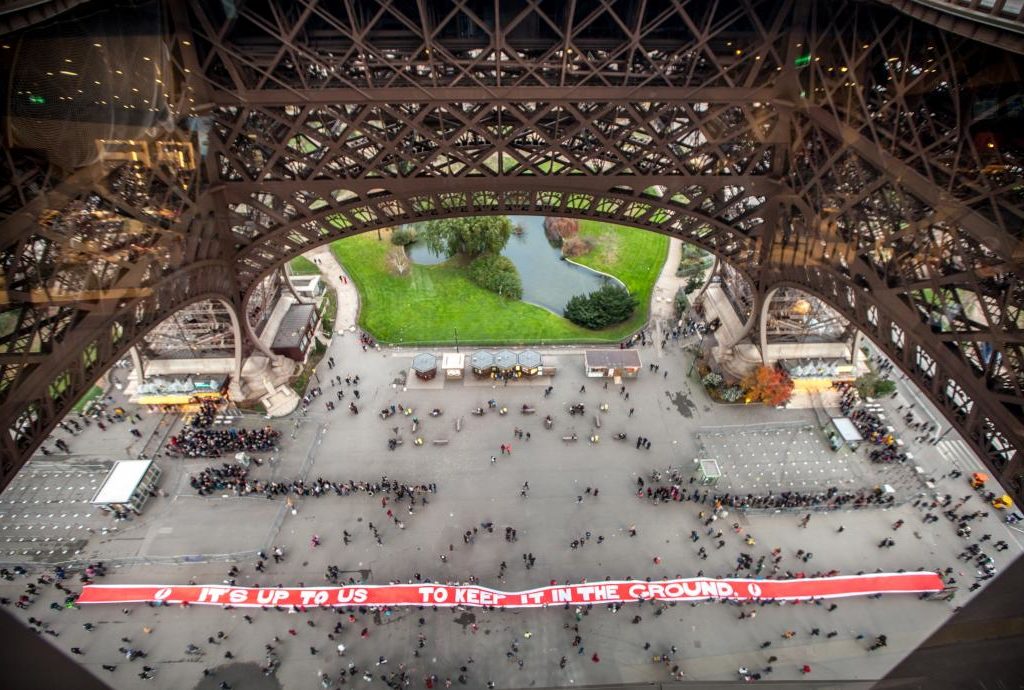Paris Was Just a Way Station in the Climate Change Fight.


On November 29, over 1 million people in 175 nations took to the streets, in the largest protest demanding immediate action on climate change in history. Among them were 10,000 people in Paris forming a mass human chain, despite a ban on protests enforced by police with batons, tear gas and concussion grenades, and who would go on to make arrests. The next day, 150 heads of state—the largest such gathering ever—came together in Paris to work towards a legally binding global accord on climate change. Thirteen days later, they succeeded.
Climate change is a global problem that demands global solutions. Today, in a period of multinational war, terrorism and widespread political extremism, perhaps the most extraordinary accomplishment of the United Nations’s 21st Conference of the Parties (COP21) climate talks that concluded in Paris on December 12 was that representatives of 196 nations sat around a table and politely hashed out extreme differences on how to spend their money, build their economies, use their natural resources, treat their citizens and engage with their neighbors. It was, according to U.S. Secretary of State John Kerry, “a victory for all of the planet and for future generations…a remarkable global commitment.”
The final Paris Agreement asserts that “climate change represents an urgent and potentially irreversible threat to human societies and the planet and thus requires the widest possible cooperation by all countries, and their participation in an effective and appropriate international response, with a view to accelerating the reduction of global greenhouse gas emissions.” It also says “deep reductions in global emissions will be required.”
Portions of the agreement are legally binding. The most significant is the commitment of each nation to submit—and review every five years—plans to reduce greenhouse gas emissions, as well as wealthy nations’ pledge to provide by 2020 $100 billion to help poorer countries transition to alternative energy economies. An additional $100 billion will be provided every year thereafter until at least 2025. The agreement also requires a new level of transparency in governments, which must now not only report national greenhouse gas emissions but also detail the source (such as a coal plant or automobiles) and be subject to a technical review of their plans by the U.N.
That’s the good news. But there are also plenty of problems with the agreement. There are no consequences if commitments are not met (in comparison to, for example, the Convention on International Trade in Endangered Species, which is enforced through trade sanctions). The Paris Agreement also acknowledges that even if the individual country climate plans are fully and perfectly implemented, they would be insufficient, potentially resulting in temperature increases of over double the limit of 1.5 degrees Celsius above preindustrial levels “pursued” by the agreement.
We’ve already hit 1 degree C of warming, and the U.N. estimates that 26 million people are displaced every year due to natural disasters. Seventy-five percent of those catastrophes “are now climate-related, with the overwhelming majority of lives lost in developing countries,” according to U.K.-based anti-poverty organization Oxfam International. And the Paris Agreement barely scratches the surface of solving the problem; Helen Szoke, one of Oxfam’s executive directors, calls the agreement “a frayed lifeline to the world’s poor.” Bridget Burns of the Women’s Environment & Development Organization says it “fundamentally does not address the needs of the most vulnerable countries, communities and people of the world. It fails to address the structures of injustice and inequality which have caused the climate crisis.”
There are several obvious failures in the Paris Agreement’s approach to helping those most vulnerable to the devastations of climate change. For example, while the promise of $600 billion through 2025 is significant, it is not enough to address either the myriad challenges of adapting to climate change or the extreme loss and damage suffered when disaster strikes. Economic damage to developing countries from climate change, in the form of droughts, floods, hurricanes, agriculture loss and more, is estimated to reach $1.7 trillion a year by 2050.
That financial pledge is also, at best, poorly defined. Nowhere does the Paris Agreement detail which country is going to pay how much, when, where, for what or from what source (public or private). Foggy accounting by donors has led to a great deal of debate as to how much money has already been put up by nations, with estimates ranging from $5 billion to $60 billion. At the behest of the U.S., the agreement includes an exemption, explaining that it “does not involve or provide a basis for any liability or compensation.” In other words, developing countries cannot ask (or sue) wealthy ones to compensate for the loss and damage suffered as a consequence of the latter’s past or current greenhouse gas emissions.
Then there’s the concern highlighted by a 300-foot-long, bright red and white banner laid out at the foot of the Eiffel Tower on December 12 by 15,000 climate justice protesters. It read: “It’s Up to Us to Keep It in the Ground.” In 2014, the U.N. Intergovernmental Panel on Climate Change concluded that in order to limit the world to 2 degrees C of warming, three-quarters of fossil fuel reserves need to stay in the ground. Yet the words “fossil fuels,” “oil,” “natural gas” and “coal” appear nowhere in the Paris Agreement. The agreement ignores production and focuses exclusively on emissions, allowing, for example, Saudi Arabia to continue and even increase production of oil for exportation as long as it attempts to reduce domestic emissions.
The agreement’s lack of action on extraction could have catastrophic effects for many at-risk communities around the world, says Alberto Saldamando, legal counsel for the Indigenous Environmental Network and a veteran of six years of COP negotiations. The agreement relies on carbon markets and the Reducing Emissions From Deforestation and Forest Degradation (REDD) mechanism, which allow for continued emissions through trading or offsets, such as the planting or maintaining of forests or other carbon sinks. But this approach allows the toxic environmental, cultural and human health effects of fossil fuel production and transport to continue, and in some cases, facilitates the expulsion of indigenous peoples from their lands.
For example, a 2011 report found that REDD policies and programs in the Peruvian Amazon enable logging, mining, oil production and agribusiness entities to continue production while indigenous small farmers are removed from their forest communities. The indigenous Amazonians call it “carbon piracy” and argue that the wrong people are being forced out of the forest: “For thousands of years indigenous peoples have looked after a living planet, and in only one hundred years industrialization has caused it to overheat,” the report says.
Moreover, a key paragraph written to ensure that the Paris Agreement would have to maintain the rights of indigenous peoples, women, workers and others fell under heavy opposition from Saudi Arabia and other nations’ governments. It was moved from the operating text to the preamble, which means it is not legally binding.
Back in the U.S.—where 78 percent of respondents said in January they want the federal government to limit the amount of greenhouse gases that businesses put out—the Paris Agreement could help break the stranglehold that industry has on Congress. For example, it undermines a key argument of many Republicans against taking global action on the climate: that America cannot act alone. It also serves to further marginalize climate change deniers, such as presidential candidate (and Iowa polls front-runner) Senator Ted Cruz, R-Texas, who in an interview last week with NPR said, “Climate change is the perfect pseudoscientific theory for a big-government politician who wants more power.”
Cruz and his ilk are increasingly in the minority in government leadership, but, says Kassie Siegel, director of the Climate Law Institute at the Center for Biological Diversity, it’s still up to “grass-roots activists to create the pressure on governments around the world as quickly as possible” to ensure that countries ratchet up and meet their climate commitments. That’s been the case for a while now. “Nearly 200 nations were compelled to act on climate because there’s a global movement that has made action a political imperative,” says Lindsey Allen, executive director of the Rainforest Action Network. “Look at the elections in Alberta and nationally in Canada”—in which oil industry favorites were ousted by candidates supporting clean energy—“if you want evidence of the movement’s capacity to bring about political change.”
The Paris Agreement has mobilized and galvanized the climate justice movement even further, which, from the onset, planned for “the road through Paris,” seeing these negotiations as a way station, not a stopping point. On December 16, a coalition made up of partners in 12 countries, including 350.org, Greenpeace International, WoMin-African Gender and Extractives Alliance, Oilwatch, Coalizão Não Fracking Brasil and the Philippine Movement for Climate Justice, launched “a global wave of resistance to keep coal, oil and gas in the ground.” It is a “global escalation against the fossil fuel industry” involving “coordinated actions of thousands of people on iconic fossil fuel projects and companies across the globe.” They’ll build off of the successful organizing that, many argue, has led in recent years to mass divestments from fossil fuels, stopped the Keystone oil pipeline, pushed Shell out of the Arctic, shut down hundreds of coal-fired power plants and banned a great deal of fracking. The goal now, though, is even more ambitious: end the fossil fuel economy and begin the era of 100 percent global renewable energy.
